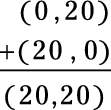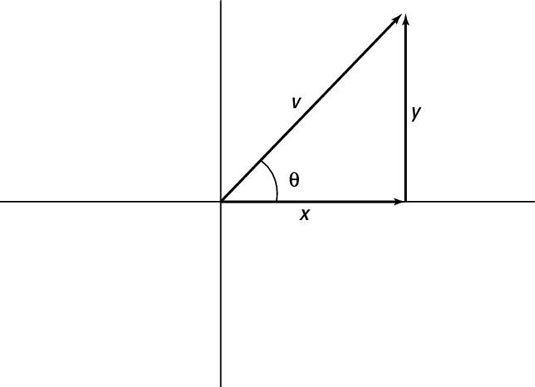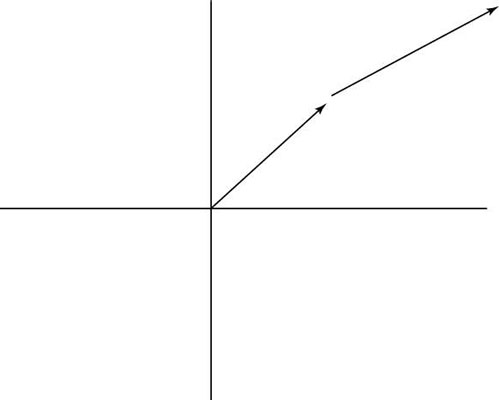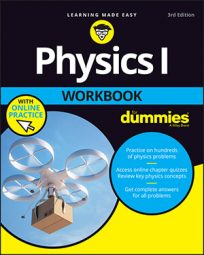You’re frequently asked to add vectors when solving physics problems. To add two vectors, you place them head to tail and then find the length and magnitude of the result. The order in which you add the two vectors doesn’t matter.
For example, suppose you’re headed to the big physics convention and have been told that you go 20 miles due north and then 20 miles due east to get there. At what angle is the convention center from your present location, and how far away is it?
You can write these two vectors like this (where east is along the positive x axis):
(0, 20)
(20, 0)
In this case, you need to add these two vectors, and you can do that just by adding their x and y components separately:

Do the math, and your resultant vector is (20, 20). You’ve just completed a vector addition. But the question asks for the vector in magnitude/angle terms, not coordinate terms. So what is the magnitude of the vector from you to the physics convention? You can see the situation in the following figure, where you have x and y and want to find v.

Finding v isn’t so hard because you can use the Pythagorean theorem:
Plug in the numbers to get
So the convention is 28.3 miles away. What about the angle theta? You know
theta = tan–1(y/x) = tan–1(20/20) = 45 degrees
And that’s it — you now know that the convention is 28.3 miles away at an angle of 45 degrees.
Sample question
-
Add the two vectors in the following figure. One has a magnitude 5.0 and angle 45 degrees, and the other has a magnitude 7.0 and angle 35 degrees.

The correct answer is magnitude 12.0, angle 39 degrees.
-
Resolve the two vectors into their components. For the first vector, apply the equation vx = v cos theta to find the x coordinate. That’s 5.0 cos 45 degrees = 3.5.
-
Apply the equation vy = v sin theta to find the y coordinate of the first vector. That’s 5.0 sin 45 degrees, or 3.5. So the first vector is (3.5, 3.5) in coordinate form.
-
For the second vector, apply the equation vx = v cos theta to find the x coordinate. That’s 7.0 cos 35 degrees = 5.7.
-
Apply the equation vy = v sin theta to find the y coordinate of the second vector. That’s 7.0 sin 35 degrees = 4.0. So the second vector is (5.7, 4.0) in coordinate form.
-
To add the two vectors, add them in coordinate form: (3.5, 3.5) + (5.7, 4.0) = (9.2, 7.5).
-
Convert (9.2, 7.5) into magnitude/angle form. Apply the equation theta = tan–1(y/x) to find the angle, which is tan–1(7.5/9.2) = tan–1(0.82) = 39 degrees.
-
Apply the equation

to find the magnitude, which is

Converting to two significant digits gives you 12.
-
Practice questions
-
Add a vector whose magnitude is 13.0 and angle is 27 degrees to one whose magnitude is 11.0 and angle is 45 degrees.
-
Add a vector whose magnitude is 16.0 and angle is 56 degrees to one whose magnitude is 10.0 and angle is 25 degrees.
-
Add two vectors: Vector one has a magnitude 22.0 and angle of 19 degrees, and vector two has a magnitude 19.0 and an angle of 48 degrees.
-
Add a vector whose magnitude is 10.0 and angle is 257 degrees to one whose magnitude is 11.0 and angle is 105 degrees.
Following are answers to the practice questions:
-
Magnitude 23.7, angle 35 degrees
-
For the first vector, use the equation vx = v cos theta to find the x coordinate: 13.0 x cos 27 degrees = 11.6.
-
Use the equation vy = v sin theta to find the y coordinate of the first vector: 13.0 x sin 27 degrees, or 5.90. So the first vector is (11.6, 5.90) in coordinate form.
-
For the second vector, use the equation vx = v cos theta to find the x coordinate: 11.0 x cos 45 degrees = 7.78.
-
Use the equation vy = v sin theta to find the y coordinate of the second vector: 11.0 x sin 45 degrees = 7.78. So the second vector is (7.78, 7.78) in coordinate form.
-
Add the two vectors in coordinate form: (11.6, 5.90) + (7.78, 7.78) = (19.4, 13.7).
-
Convert (19.4, 13.7) into magnitude/angle form. Use the equation theta = tan–1(y/x) to find the angle: tan–1(13.7/19.4) = tan–1(0.71) = 35 degrees.
-
Apply the equation

to find the magnitude, which is

-
-
Magnitude 25.1, angle 44 degrees
-
For the first vector, use the equation vx = v cos theta to find the x coordinate: 16.0 x cos 56 degrees = 8.95.
-
Use the equation vy = v sin theta to find the y coordinate of the first vector: 16.0 x sin 56 degrees, or 13.3. So the first vector is (8.95, 13.3) in coordinate form.
-
For the second vector, use the equation vx = v cos theta to find the x coordinate: 10.0 x cos 25 degrees = 9.06.
-
Use the equation vy = v sin theta to find the y coordinate of the second vector: 10.0 x sin 25 degrees = 4.23. So the second vector is (9.06, 4.23) in coordinate form.
-
Add the two vectors in coordinate form: (8.95, 13.3) + (9.06, 4.23) = (18.0, 17.5).
-
Convert the vector (18.0, 17.5) into magnitude/angle form. Use the equation theta = tan–1(y/x) to find the angle: tan–1(17.5/18.0) = tan–1(0.97) = 44 degrees.
-
Apply the equation

to find the magnitude, which is

-
-
Magnitude 39.7, angle 32 degrees
-
For the first vector, use the equation vx = v cos theta to find the x coordinate: 22.0 x cos 19 degrees = 20.8.
-
Use the equation vy = v sin theta to find the y coordinate of the first vector: 22.0 x sin 19 degrees, or 7.16. So the first vector is (20.8, 7.16) in coordinate form.
-
For the second vector, use the equation vx = v cos theta to find the x coordinate: 19.0 x cos 48 degrees = 12.7.
-
Use the equation vy = v sin theta to find the y coordinate of the second vector: 19.0 x sin 48 degrees = 14.1. So the second vector is (12.7, 14.1) in coordinate form.
-
Add the two vectors in coordinate form: (20.8, 7.16) + (12.7, 14.1) = (33.5, 21.3).
-
Convert the vector (33.5, 21.3) into magnitude/angle form. Use the equation theta = tan–1(y/x) to find the angle: tan–1(21.3/33.5) = tan–1(0.64) = 32 degrees.
-
Apply the equation

to find the magnitude, which is

-
-
Magnitude 5.2, angle 170 degrees
-
1.For the first vector, use the equation vx = v cos theta to find the x coordinate: 10.0 x cos 257 degrees = –2.25.
-
Use the equation vy = v sin theta to find the y coordinate of the first vector: 10.0 x sin 257 degrees, or –9.74. So the first vector is (–2.25, –9.74) in coordinate form.
-
For the second vector, use the equation vx = v cos theta to find the x coordinate: 11.0 x cos 105 degrees = –2.85.
-
Use the equation vy = v sin theta to find the y coordinate of the second vector: 11.0 x sin 105 degrees = 10.6. So the second vector is (–2.85, 10.6) in coordinate form.
-
Add the two vectors in coordinate form: (–2.25, –9.74) + (–2.85, 10.6) = (–5.10, 0.86).
-
Convert the vector (–5.10, 0.86) into magnitude/angle form. Use the equation theta = tan–1(y/x) to find the angle: tan–1(0.86/–5.10) = tan–1(–0.17) = 170 degrees. Because x is negative and y is positive, this vector must be in the second quadrant.
-
Apply the equation

-
to find the magnitude, which is

-

